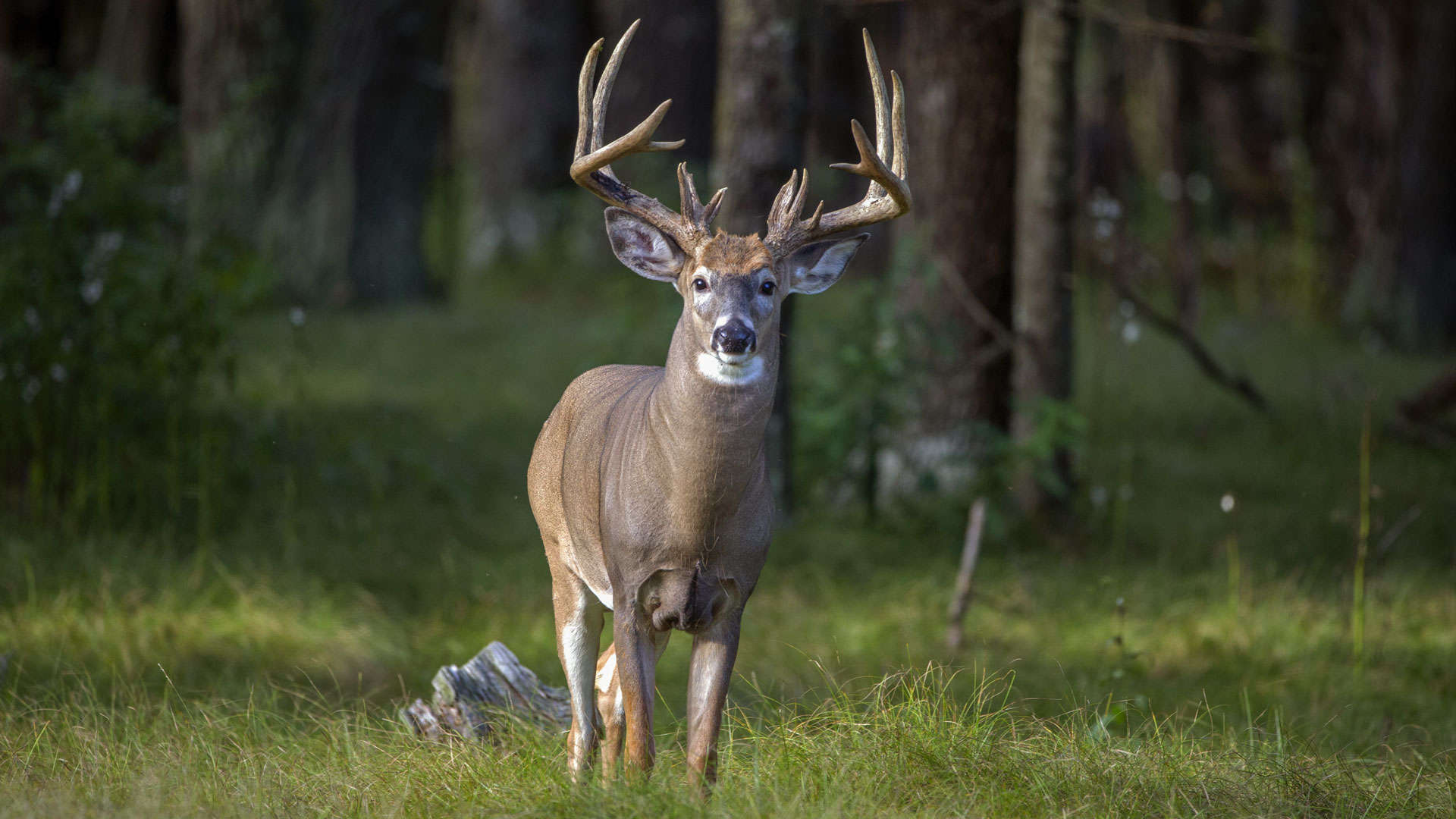
Where the East ends and the West begins depends on where you might be standing at a particular moment in time, and your eagerness to debate the delineation. For me it was the first time I drove across the Missouri River bridge at Chamberlain, S.D., on my first deer hunt. The cornfields of eastern South Dakota disappeared in the rearview mirror as our old International Scout plunged into a new world. Chiseled, cedar-studded river breaks were the gateway to yucca draws, lunar-like badlands and the pine-covered mountains beyond.
Both flavors of deer inhabited the vacant landscape, but from that road trip decades ago till this day, whitetail pursuits make up the majority of my Western deer hunts. Theodore Roosevelt eloquently describes the allure of the West in a letter written in the classic Western setting of the North Dakota Badlands: “I heartily enjoy this life, with its perfect freedom, for I am very fond of hunting, and there are few sensations I prefer to that of galloping over these rolling limitless prairies, with rifle in hand, or winding my way among the barren, fantastic and grimly picturesque deserts of the so-called Bad Lands … .”
No doubt his hunting included elk and mule deer, but his ranch setting along the Little Missouri River also held the prospect of hunting whitetails that thrived in the cottonwood bottoms and adjoining breaks. Even though horses and one personable mule reside in my Wyoming pasture, I seldom gallop to my whitetails. Nevertheless, I never overlook an opportunity to pursue the whitetail as it ever expands across the immenseness of the American West.

Always a Fixture of the West
Some hunters view whitetails as a fixture held firmly in easterly locales by the confines of the mighty Missouri. Muleys hold the lease to lands west. That general boundary works for muleys unable to find necessary environmental elements for survival to the east. It doesn’t work for whitetails that were already a constant in the Western topography well before the first European pioneer plowed a new furrow in the region.
As early as May 10, 1805, journal notes by Meriwether Lewis in Montana mentioned the presence of white-tailed deer in the West. The notes described a successful hunt for “two Mule deer, one common fallow or longtailed deer,” later to be identified as the Dakota subspecies of whitetail.
Today whitetails and their subspecies can be found in all of the 48 contiguous states with wagers on them arriving in Alaska at some point in the 21st century. Hawaii might be out of reach until the return of Pangea, but don’t bet on it as whitetails have a knack for populating questionable environments.
Today, Western whitetail hunters frequent the plains, foothills and mountains of Colorado, Idaho, Montana, Oregon, Wyoming and Washington with populations to pursue. The remaining Western states have either limited densities or subspecies, such as the Coues whitetail.
As a nonconformist and maverick, I add a few additional states to the West beyond those defined by the U.S. Census Bureau. Why? If you ever ventured into the Badlands of the Dakotas, the Pine Ridge or bluffs of western Nebraska, Mount Sunflower in Kansas or the panhandle of Oklahoma, you realize this is where the West really begins. Prairies rise, vegetation shifts to semi-arid varieties, and pines and junipers take the place of deciduous varieties of timber. If Teddy Roosevelt considered it the West I’m not one to argue.
So why do Westerners use terms such as “invasive” or “homewreckers” when labeling Western whitetails despite their foothold before the European invasion? That first sodbuster kicked off a trend expanding the green zones of agriculture throughout the lowlands and accepting uplands of the West. Whitetails can survive on native browse and the edges of evergreen stands. They surge beyond survival when those edges are defined, particularly with crops boosting nutrition levels to the equivalent of a daily six-pack dose of the Ensure nutrition drink. More food, friendlier surroundings and an ever-expanding green pathway through the West spurs the whitetail derogatory comments. Some believe whitetails may someday be the demise of mule deer, but muleys have significant demons beyond the “longtailed” deer labeled by Lewis.
Despite their tenacity to forge westward, whitetails still require a bit of home to make them happy. You’ll rarely find them living an existence under a complete conifer canopy. One of my go-to elk hunting locations in the Bighorn Mountains of Wyoming seems to attract its share of elevation-loving whitetails. My trail cameras capture their antics near shrouded elk wallows, and shed antler discoveries reveal their boldness to join wintering elk on open, steep, south-facing slopes. As environmentally accepting as they appear, whitetails can’t live entirely in a mountain or sagebrush setting even if it offers ideal browse, plus refuge protection like southern slopes.
Understanding their needs and adaptability gives you a jumpstart as you look at a chunk of country with hopes of meeting a whitetail. Here are some twists to make that meeting more probable.

Find the Deer
Don’t be fooled by the reports of locals claiming that carpetbagger whitetails are everywhere. You may find them in heavily populated pockets, but lower overall densities require you to search with purpose. This rings true for public-land hunters contained even further by boundaries combined with environmental factors.
Locations like Idaho and northeastern Washington include massive acres of timber. Those deer will still adhere to an edge lifestyle, but those edges could be subtle in the form of parks, wetlands or valley meadows that may be off limits due to private ownership in lowlands. View the location from above and with topographical assistance. Satellite imagery can reveal concealed openings, and the topo support may reveal benches and saddles deer could use to avoid steep travels from mountain to mountain. Benches also serve as good resting places for whitetails during the midday while not rutting.
Even if your hunt lasts only a few days, the use of a trail camera, where legal, could help reveal travel patterns. A Montana hunter I share information with follows a credo of putting in at least two days of scouting for every day of hunting. He breaks that rule as the rut unwinds, but the extra hours help him locate deer to target in an endless landscape that oftentimes appears to be the same.
Prairies and foothills don’t require nearly as much trail-camera maintenance, but they do require eyeball time behind optics. Whitetails could be living in the lap of luxury on a cottonwood bottom surrounded by hayfields re-energized from a fall rain to sprout browse “longtails” can’t ignore.
Unfortunately, whitetails also live in the broken openness of eastern Colorado or other territories that saddle up to the looming Rockies. Many of these locations have a uniform appearance. I once went after a double drop-tine whitetail that lived amongst dinosaur bone beds in badland geography not far from the Black Hills. The cagey buck rarely visited a tilled field and would hide as easily as a Tyrannosaurus could in the sedimentary rocks and clay castles of its homeland. Shed antlers were all I ever saw of the brute, but I heard two years after my try the buck slipped up on an extended rutting foray, making one public-land hunter mighty happy.
In any cowboy setting, one November factor ups the odds for whitetail success: does. Despite lower densities and a willy-nilly existence, a congregation of does is all it takes to draw in a buck. Even if your initial scouting, whether preseason or on-the-go, doesn’t reveal a shooter, remain optimistic. Western whitetails haven’t read the textbooks on how they need to stay within a square-mile homeland. While on a hunt with Chad Schearer, CVA’s marketing director, we both shared tales of Western whitetails traveling 8 miles or more during the melee of the rut. In some districts a heavy snowfall accompanying November breeding can spur migrations of 20 miles or more for mountain whitetails. One day you may be eyeballing yearlings through a spotting scope, and when the weather clears a gnarly old-timer could be visible at sunrise.
You can’t ignore the sprawling and ever-expanding homesteads of the new Western pioneers. The foothills and valleys of the West are being dotted with additional homes, and whitetails can’t ignore the added green spaces. While scouting, pay attention to small acreages and the edges of towns. If whitetails inhabit the area, the shrubs, landscaping and sod won’t go unnoticed.
My son’s first whitetail was just such a city socialite. The Wyoming property we had permission to hunt was connected to the city limits by a snaking, riparian zone. Whitetails followed it in and out of town like commuters. One frosty November morning, we watched a buck prod a doe from the city’s edge to a sagebrush basin nearby. When they bedded out of sight we crawled to a vantage point from above, and my son perfectly planted a Hornady SST in the vitals of the love-struck buck to kick off his whitetail career.

Know Which Side of the Fence You May Hunt
Knowing where you stand not only keeps you from becoming a mission for a Western search-and-rescue team; it could also keep you free of a trespassing charge. It’s not uncommon at all to hunt public parcels that intermix with private holdings without fence lines to guide you. Plus, it’s common for property owners to fence for convenience, not according to surveys. Your public property could extend beyond a posted fence line or vice versa. Having accurate coordinates is imperative, and that means relying on either your GPS or smartphone to relay that information to you instantly.
One of the leaders in property ownership information is OnXmaps. This pioneering company offers access to property ownership, hunting unit information, topography and aerial imagery. Information can be accessed via cellular service or downloaded. Garmin GPS, Apple, Android and home-based Web platforms all offer accessibility. You can have access anywhere regardless of cellular service simply by saving the maps you need to your device.
Another innovator that includes property information is ScoutLook Weather. Created as a weather aid to hunters, the app has been tweaked with additional support elements for all aspects of your hunt. You’ll get not only exceptional weather forecasting but also unique graphics to show your scent dispersion with current wind direction. The app allows you to note important sign with the “ScoutMarX” feature to mark trails, trailheads, camp, food plots, scrapes, blood trails and more. Use the ScoutLook logging system to keep track of game activity with logging options dedicated to big game, deer, turkeys, predators, waterfowl and hogs. You can even share your findings with friends via the app.
ScoutLook Weather teamed with Google Earth for aerial imagery so you can overlay graphics such as topography, and it recently added a new “Property Lines” feature. Tap on the interactive map to see property lines, property sizes, landowner information and other helpful property details. Save locations and you’ll have access to offline viewing even when you can’t ring out.
The West is a big place. Use one of these popular aids to avoid getting lost or crossing the wrong fence. When you’re confirming or looking for new property, it’s the fast track to more hunting access.
Stay on Your Feet
“I can’t believe the deer are out in broad daylight!”—that’s a common response from visitors to the West during any season. Even when harvest befalls the limitless cover of crops in traditional whitetail country, most times it still doesn’t make finding whitetails easy in the open or strip environments.
Keep that important behavioral factor in mind while hunting Western whitetails. There’s no need to return to camp or town for a midday siesta if you know deer are in the neighborhood. They’ll move on and off all day long. Sometimes hunting pressure could urge them to move about inside cover, but they could just as easily visit an opening at midday. Wintry weather could slow the dance moves a bit. Regardless, I’ve taken my fair share of big bucks at high noon and during ground blizzard conditions. Stay out until you tag out or the state shuts down the roads.
A high lookout at sunrise could reveal deer moving to evergreen slopes, into bottomland willows or escaping to chiseled buttes that rouse memories of your favorite Hollywood Western. If you’ve never been a user of spotting scopes it may be time to do so. A spotting scope, when accompanied by a binocular with a wide field of view, can save you lots of legwork. A spotting-scope evaluation could determine if the calories are worth chasing a whitetail slipping up the opposite canyon in Idaho’s Snake River country, for instance.
Another familiar phrase I hear, particularly from Easterners, is that whitetails seldom come to a whitetail call. Get ready for a change while calling points west. Their welcoming response to calls could come from the fact that they don’t receive hunting pressure as intense as some parcels east. More likely is the fact that scattered densities spur roaming bucks to listen as much as look for a cooperative, copulating partner.
Rattling gives you the volume to lure bucks across the plains and to sucker in a buck hiding amongst a dog-hair stand of mountain evergreens. In dense cover the use of grunts, bleats and snort wheezes all could be productive. Like your mother begged as you left for college, “call often” to ensure your message is always fresh as you stalk across new horizons.
Crawling and Other Craziness
You’ve heard all the accolades for being fit, but for Western whitetails it’s more than just an ad for a gym membership. Despite millions of acres of national forest, BLM, state and wildlife refuge lands available to hunt, the majority see pressure. Nevertheless, as studies suggest, most hunters only push 1 mile past the trailhead. You need to go farther, deeper and more remote. That doesn’t mean leaving civilization behind. Some of the best public-land whitetail hunting I’ve discovered took me an hour or more to access, but its productivity was based on circling to an outside edge of public canyons that overlooked private hayfields. Whitetails fed on the private land but raced to the rough country at daybreak for shelter. You don’t get to locations like that by spending your off hours binging on Netflix and Krispy Kreme donuts.
Being marathon-fit isn’t required, but you should be able to hike 5-6 miles a day. If you’re successful, it also means packing out a whitetail on your back. I’ve witnessed a handful of hunters attempting to drag whole deer back to the road or even hunting with the bouncy company of a deer cart. Kudos if that’s your choice, but a much easier approach is to hunt with a sizeable backpack loaded with the gear to debone a deer. That includes a sharp knife, game bags and know-how. How much weight you pack out depends on the size of the deer and whether you pack out the cape. Expect anywhere from 50 to 80 pounds in your pack after success. During pre-hunt workouts, wear a weighted backpack to mimic your celebration.
Another reason for being fit includes the aspect of crawling. Western whitetails look for vertical figures, especially in the foothills or plains. More common than a windy day in the West is having to drop to your belly and crawl the last 30 to 100 yards to reach a rise and shoot. Walking upright with the possibility of silhouetting your form is sure to send those white tails flagging. Crawling on your belly requires upper- and lower-body strength not acquired by pushing buttons on your TV remote.
I’ve found it helpful to approach ridges, openings and other exposed areas in a hunched form. This routine gives you the appearance of another ungulate or even a friendly bovine. In dim light, fog, snow flurries or other visibility-reducing factors, it could fool a wandering whitetail.
One afternoon I had dropped off a pine mesa with fog enveloping the surroundings. I hunched over to cross a creek-side plain when I spied a deer 200 yards away charging my position. A check through my binocular confirmed it was a whitetail buck, and a bruiser at that. Slowly I dropped to my belly with a bipod stabilizing my rifle. He skidded to a halt at 100 yards, and the slap of the bullet against hide was my cue to open the backpack butcher shop as the Western signature of the mountains disappeared in the misty shroud.

Training to Shoot the West
The fear of taking a long shot may surge through you while contemplating a venture west. Those endless views and expansive distances can be worrisome. Being fit and flexible provides you some comfort in ducking behind terrain and halving the distance, but you should also test your shooting proficiency.
Set up targets at distances you’d feel comfortable assessing and engage each with three-shot groups. Your cartridge will dictate how far you should test as your projectile will need to hit with approximately 1,000 ft.-lbs. for most bullets to expand accordingly. That could mean testing out to 600 yards to see if you can consistently hit a basketball-sized target.
If you wish to hone those shooting skills prior to your hunt there are any number of long-range shooting schools open for business. I recently attended The Bergara Academy near Belt, Mont. The school offers options for two-, three- and five-day sessions taught by Bart Bartholomew, who served as a Marine primary marksmanship instructor and later worked with the Baltimore Police Department SWAT team in a sniper position. Bartholomew was the third recipient of the prestigious Carlos Hathcock Award for precision marksmanship.
Intense training sessions move from the classroom to the field with more than 50 targets cloaked and scattered from 100 to 1,400 yards. Instruction includes understanding mils, reading wind via mirage, and how to set up for maximum stability and overwatch. You can even add prairie dog hunts or world-class trout fishing as a way to capitalize on your Montana experience. It’s all set in a lodge backdrop. For more information on The Bergara Academy, call 877-892-7544 or go to bergarausa.com.



































